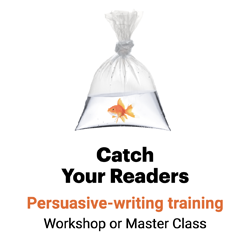‘Signal words’ help readers follow along
“Signal words” — aka transitions — are the narrative glue that helps readers see what’s coming next, understand your whole message and see how the parts fit together (Herber, 1978).

“If we encounter thus, therefore, consequently and the like, we know that the next statement should follow logically from whatever has already been presented,” writes Bonnie J. F. Meyer, Ph.D., professor of Educational Psychology at Penn State. “If we see nevertheless, still, all the same or the like, we must be prepared for a statement that reverses direction.”
Easier to remember.
In one study, for instance, a group of junior college students read a piece about supertankers that included transitions. Another group read the same piece with the signaling deleted.
Let’s pause and ponder that for a minute too.
The deletions had no effect on the ability of the best or worst students to remember and write down what they’d read. But those transitions did make a difference for average readers. With the signal words, the average students remembered more and organized the information better (Marshall 1976, Meyer 1975).
Form follows function.
Which transitions should you use? Let your story’s structure determine what kind of glue to choose.
Reading experts Joanne and Richard Vacca (1973) classify these types of internal transitions:
- Cause/effect: because, since, therefore, consequently, as a result, this led to, so that, nevertheless, accordingly, if … then.
- Compare/contrast: however, but, as well as, on the other hand, not only … but also, either … or, while although, unless, similarly, yet
- Time order: on (date), not long after, now, as, before, after, when
- Listing: to begin with … first … second …, next, then, finally
Use conjunctions and connectives.
Words like and, but, and or serve as “linguistic mortar” to explain the relationships among and between facts in your copy.
People prefer to read, are able to read faster and have better memory for sentences connected by explicit conjunctions, according to a host of research (Katz and Brent 1968, Marshall and Glock 1978-79, Pearson 1974-75).
For instance, in one study (Pearson 1974-75), this passage …
“Because John was lazy, he slept all day”
… performed better than this one:
“John was lazy. He slept all day.”
So don’t drop the transitions.
___
Sources: Robert C. Calfee, and R. Curley, “Structures of prose in content areas,” In Understanding reading comprehension, ed. J. Flood. Newark, DE: International Reading Association, 1984, pp. 161-180
Bonnie J. F. Meyer, “Reading Research and the Composition Teacher: The Importance of Plans, College Composition and Communication, Vol. 33, No. 1 (Feb., 1982), pp. 37-49
Bonnie B. Armbruster, “The problem of inconsiderate text,” in Comprehension instruction, ed. G. Duffey. New York: Longmann, 1984, pp. 202-217

Leave a Reply